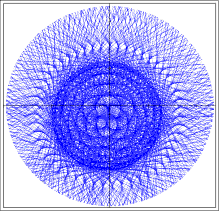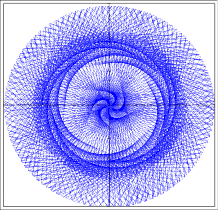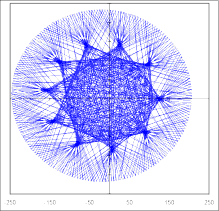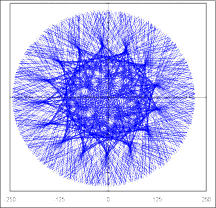The rotation of Venus is one of the enigmatic phenomena in our solar system. It could not be determined until 1964 (based on radar examinations); its period lasts 243.019 days, by far the longest of all planets. Moreover, Venus rotates retrograde, i.e. against the general rotational direction of the other planets. This odd rotation is nowadays explained partly by tidal influences of the Sun, partly by chaotic effects, that might have led to an overturn of the axis of rotation. As we will see shortly, the peculiar rotation of Venus stands also in geometrical relationship to all planets up to Jupiter.
From the period of rotation one can calculate, that one day on Venus lasts 116.75 days on Earth. In other words, a given point on Venus’ surface or a defined horizontal axis faces the Sun every 116.75 Earth days. Of course we can also compute, when this particular defined axis is pointing to the other planets. For the Earth this results in a mean period of 145.93 days, with actual intervals varying considerably around this value. In the following the alignment of the defined axis from Venus to the Earth is called Venus-Earth-View, from Venus to Mercury Venus-Mercury-View etc. If we plot the linklines between Venus and Earth (and those between Venus and the other planets) at these particular points in time continually over a long period, we obtain the following figures:
Figure 3.1 3.4 Linklines. Top left: Venus-Mercury at Venus-Mercury-View, 800 times, period approx. 255.7 years. Top right: Venus-Earth at Venus-Earth-View, 700 times, period approx. 279.7 years. Bottom left: Venus-Mars at Venus-Mars-View, 500 times, period 159.8 years. Bottom right: Venus-Jupiter at Venus-Jupiter-View (detail enlargement 10/3), 750 times, period 472.5 years; scale in millions of km. © Keplerstern Verlag
As we can see, the resulting figures are structured by the numbers four, five, ten and fifteen in a very striking numerical order. Please note that it is not self-evident, that regular forms evolve at all. If you execute the corresponding computations with fictitious periods of rotation or with those planets not mentioned here, the result is often a jumble of lines.
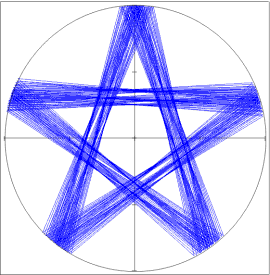 If we look at these phenomena, however, wee see that the riddle behind the rotation of the bodies in our solar system is far from being solved. As examples we shall show two more graphics in this summary, featuring the interplay with Sun and Moon. The first shows the combination of the rotations of Venus and the Sun. If we fix a horizontal axis on the Sun (as with the planets), the positions of this axis (as points on the circular surface) will be continually plotted and their sequence connected by lines. This happens within the period of one day on Venus or, more exactly, of the Venus-Sun-Views, because there are fluctuations around the mean value, too, albeit only relatively insignificant ones.
If we look at these phenomena, however, wee see that the riddle behind the rotation of the bodies in our solar system is far from being solved. As examples we shall show two more graphics in this summary, featuring the interplay with Sun and Moon. The first shows the combination of the rotations of Venus and the Sun. If we fix a horizontal axis on the Sun (as with the planets), the positions of this axis (as points on the circular surface) will be continually plotted and their sequence connected by lines. This happens within the period of one day on Venus or, more exactly, of the Venus-Sun-Views, because there are fluctuations around the mean value, too, albeit only relatively insignificant ones.
Figure 3.5 Solar rotation at Venus-Sun-Views, 250 times, period 79.91 years. Sun rotation defined as the mean period of revolution of the Sunspots, i.e. 25.38 days. © Keplerstern Verlag
Thus the relation between the Sun’s movement – for its movement may be considered as its rotation – and the Venus rotation fits excellently into the numerical series of planetary movements mentioned when they are viewed from Venus. The pentagram emerges in this case because 23 solar rotations correspond almost exactly to 5 Venus-Sun-Views (the exact value is 23.0005 Sun rotations). Finally let us have a look at the movement of the Moon on its orbit around the Earth, when ever it is viewed, as it were, by the Sun. This period equals the synodic (related to the earth) period of Sun rotation with a mean value of 27.275 days.
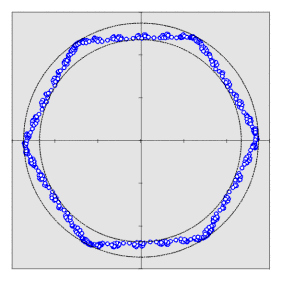
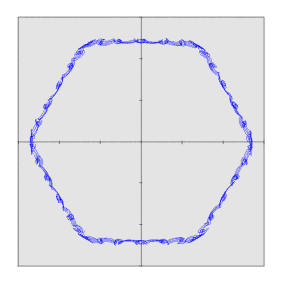
Figure 3.6 The Moon at Sun-Earth-Views. Left: 588 times, period 43.91 years. Right: 2352 times (4 x 588). In this case the connecting lines only are shown. The circles on the left mark the possible aphelion and perihelion positions of the Moon. © Keplerstern Verlag
This most amazing hexagon, precisely drawn as though with a ruler, evolves step by step as the Moon returns to almost the same position as before. It is only completed after 588 Sun-Earth-Views. The Moon does dally somewhat on its hexagonal course. Especially in the graphic on the right you can see small loops that result from certain fluctuations in the intervals of the Sun-Earth-Views which do not exceed 0.15 days. But this in combination with specific lunar rhythms of movement is sufficient to cause our companion to reach the next point either a little before or a little after its former position. The arithmetical reason for the formation of a regular hexagon must be sought in the harmony of all periods involved (explained in more detail in Signature of the Celestial Spheres, page 183 f).
One of the most profound mysteries of the universe consists in the fact that everything in it rotates, wrote the English astronomer Arthur Eddington. We would like to extend this statement to the effect that the way the celestial bodies of our solar system rotate around their own axes is probably just as great a mystery.

